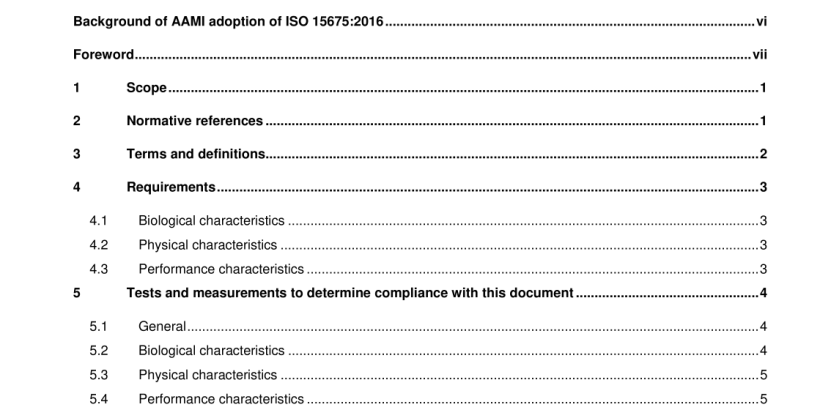ANSI AAMI ISO 15675-2016 pdf download
ANSI AAMI ISO 15675-2016 pdf download.Cardiovascular implants and artificial organs— Cardiopulmonary bypass systems—Arterial blood line filters
5.4.1.2 Procedure
Two sets of appropriate, identical circuit components, including a pump, connecting tubing, a reservoir (as specified by the manufacturer and of suitable size relative to the device under test), and a heat exchanger, shall be assembled. The device under test shall be placed in one of the circuits. A predicate device shall be placed in the second test circuit. Priming and debubbling of the circuits by recirculating with an appropriate solution is recommended before blood is added. The blood pathway test-liquid volumes shall, at the initiation of the test, be within 1 % of each other. Perform the test in vitro using the conditions given in Table 1 . A sufficient number of paired tests should be performed to support a statistical analysis. The predicate filter should be tested under the same conditions. Compliance shall be verified by test or by inspection of the manufacturer’s documentation on blood cell damage for the finished device, in accordance with ISO 1 0993-4, as applicable.
5.4.2.1 Test liquid
The test liquid shall be a glycerin solution or water. The test liquid shall contain 350 to 5,000 particles per ml that are 1 5 % to 25 % larger than the nominal pore size of the filter. 5.4.2.2 Procedure Pass 500 ml of the test liquid at room temperature (20 C to 22 C) through the arterial blood line filter at a flow rate of no less than 1 00 ml/min and a pressure not exceeding 1 52 kPa (22 psi) gauge. Determine the pre- and post-filtration mean number of particles. The test shall be performed at the manufacturer’s recommended flow rates. Calculate the filtration efficiency, using the readings from the size range of the test particles used for each test sample, by subtracting the post-filtration mean number of particles from the pre-filtration mean, dividing the quotient by the pre- filtration mean number of particles, and multiplying by 1 00 to obtain a percentage.
5.4.3 Filter flow rate
5.4.3.1 Test liquid The test liquid shall be anticoagulated whole blood or a blood analogue.
5.4.3.2 Procedure Place the device under test in an appropriate test circuit. Set the flow rate at the maximum rated flow and monitor the inlet and outlet pressures across the filter for 6 h. Measure the flow rate using a calibrated flowmeter. Note any pressure changes during the test. If anticoagulated whole blood is used, this test shall not take into account the effects of formed elements or proteinaceous aggregates.
5.4.4 Shelf life Using a validated method, ageing should be performed on final, finished, sterilized, devices in primary packaging in order to determine nominal shelf life.
5.4.5.2 Procedure
Use filter vent tubing as specified in the IFU. The length and internal diameter of the vent tubing shall be specified. The back pressure at the maximum test flow shall be 26.6 kPa (3.9 psi) ± 5 %. Use a bubble eliminator to measure any air downstream of the filter accumulated over a period of 5 min from bolus injection. At flow rates of 33 %, 67 %, and 1 00 % of the specified maximum rated flow rate, 30 ml (for paediatric or infant arterial filter with a maximum flow rate of less than 500 ml/min, the bolus shall be 2.5 ml and for maximum flow rates higher than 500 ml/min, the bolus shall be increased by 2.5 ml for every 500 ml/min maximum flow rate; the maximum bolus shall be 1 0 ml) shall be injected as a single bolus. Indication of the air bolus injection point in the test circuit, rate of injection, and type of pump utilized to circulate test liquid should be provided in the test protocol.
